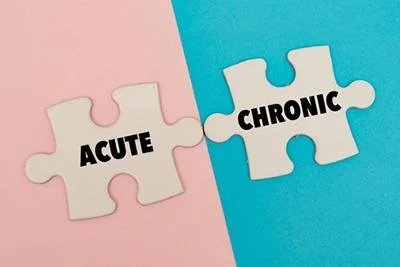When it comes to understanding health conditions, one of the most important distinctions is between acute and chronic diseases. These terms are often used to describe different types of health conditions, but they have distinct meanings. In this article, we will dive into the key differences between acute vs chronic diseases, how they affect the body, and what treatment options are available for each.
Introduction
Health conditions can be classified into two broad categories: acute and chronic. Both terms refer to the duration and severity of the disease, and they play a critical role in determining how a condition is diagnosed, treated, and managed. Understanding the difference between acute and chronic conditions is crucial for both patients and healthcare providers in making effective treatment plans.
While the terms may seem simple at first, the distinctions between acute and chronic diseases are much more than just how long they last. In fact, the onset, symptoms, progression, and treatment options can vary dramatically. By gaining a clear understanding of these differences, individuals can better navigate their health journey, manage symptoms, and make informed decisions about their care.
The Key Differences Between Acute and Chronic Health Conditions
What is Acute Disease?
An acute disease refers to a condition that begins suddenly and typically has a short duration. Acute diseases often come on quickly, presenting with noticeable symptoms that appear rapidly and can escalate within a short time frame. These conditions may last from a few days to a few weeks, and in many cases, they resolve with appropriate treatment or even without treatment. Acute diseases are often temporary, but they can be severe, and they may require immediate medical attention to prevent complications.
Characteristics of Acute Diseases
- Sudden Onset: Acute diseases often begin suddenly with noticeable symptoms.
- Short Duration: They last for a brief period, from a few days to several weeks.
- Severe Symptoms: Acute conditions may cause intense symptoms, such as pain, fever, or swelling.
- Treatable: Many acute diseases are treatable, and symptoms can subside with medication or rest.
Common examples of acute diseases include:
- Influenza (Flu)
- Acute Appendicitis
- Pneumonia
- Acute Myocardial Infarction (Heart Attack)
- Acute Bronchitis
What is Chronic Disease?
Chronic diseases, on the other hand, are long-lasting conditions that persist over time, often for months, years, or even a lifetime. These diseases typically progress slowly and may have periods of flare-ups followed by periods of remission. Unlike acute diseases, chronic conditions can significantly affect a person’s quality of life, as they are ongoing and often require continuous management.
Acute vs Chronic diseases may not have a sudden onset like acute conditions, but they can cause long-term health problems and complications if left unmanaged. They are often more complex and harder to treat than acute diseases, requiring ongoing medical care, lifestyle changes, and sometimes medication.
Characteristics of Chronic Diseases
- Long Duration: Chronic diseases last for months, years, or even a lifetime.
- Gradual Onset: They often develop slowly, and symptoms may not be immediately noticeable.
- Persistent or Recurrent Symptoms: Symptoms of chronic diseases can vary in intensity and may worsen over time.
- Requires Ongoing Management: Chronic diseases often require continuous treatment, lifestyle changes, and regular monitoring.
Common examples of chronic diseases include:
- Diabetes
- Hypertension (High Blood Pressure)
- Arthritis
- Chronic Obstructive Pulmonary Disease (COPD)
- Heart Disease
Acute vs Chronic Disease: Key Differences
To truly understand the difference between acute and chronic diseases, it’s helpful to compare the two in terms of several key factors:
1. Duration
- Acute Diseases: Short-term conditions that last for a limited period.
- Chronic Diseases: Long-term conditions that persist for months or years, sometimes for a lifetime.
2. Onset
- Acute Diseases: Often have a sudden onset, with symptoms appearing rapidly.
- Chronic Diseases: Develop slowly and can sometimes be asymptomatic in the early stages.
3. Severity
- Acute Diseases: Can be severe or life-threatening, but symptoms tend to resolve with treatment.
- Chronic Diseases: Often less immediately severe but can lead to long-term health problems and complications.
4. Treatment
- Acute Diseases: Generally respond well to treatment and may resolve completely after a short period of care.
- Chronic Diseases: Require ongoing management, medication, lifestyle changes, and sometimes long-term care.
5. Prognosis
- Acute Diseases: Often have a favorable prognosis, with complete recovery possible in many cases.
- Chronic Diseases: Have a less predictable course and often require long-term management to control symptoms and prevent complications.
Managing Acute and Chronic Diseases
Treatment for Acute Diseases
Acute diseases typically require immediate medical attention to alleviate symptoms and prevent complications. Treatment options depend on the nature of the disease but may include:
- Antibiotics or Antiviral Medications (for infections)
- Surgery (in cases like appendicitis or a heart attack)
- Rest and Hydration (for mild conditions like the flu)
- Pain Relief (for conditions with intense pain, such as a sprain or injury)
Most acute diseases are treatable and can be managed with timely intervention. After treatment, the individual often recovers fully, although follow-up care may be necessary in some cases.
Managing Chronic Diseases
- Medications to control symptoms and slow disease progression (e.g., insulin for diabetes, blood pressure medication for hypertension)
- Lifestyle Changes such as diet, exercise, and weight management
- Regular Monitoring through blood tests, screenings, or other diagnostic tools
- Physical Therapy to maintain mobility and function (especially in conditions like arthritis)
- Supportive Care such as counseling or support groups for conditions like chronic pain or mental health disorders
Chronic diseases may not be curable, but with proper treatment and management, individuals can lead full, active lives. For individuals managing vascular-related chronic conditions, specialized treatment and ongoing care from Metro Vein Centers can help maintain healthy circulation and prevent complications associated with poor vein function.
Summing Up
Understanding the difference between acute vs chronic diseases is essential for managing health and making informed decisions about treatment. Acute diseases are short-term, often severe, and require immediate treatment but typically resolve with medical care. Chronic diseases, on the other hand, are long-lasting, require ongoing management, and may lead to long-term health complications if not properly controlled.
By recognizing the characteristics and differences between acute and chronic diseases, individuals can better navigate their healthcare journey, seek appropriate treatments, and manage their conditions effectively. Whether dealing with an acute illness or living with a chronic condition, seeking timely medical advice and following recommended treatment plans can significantly improve health outcomes and overall well-being.
Explore expert tips and ideas that make a real impact—learn more.






